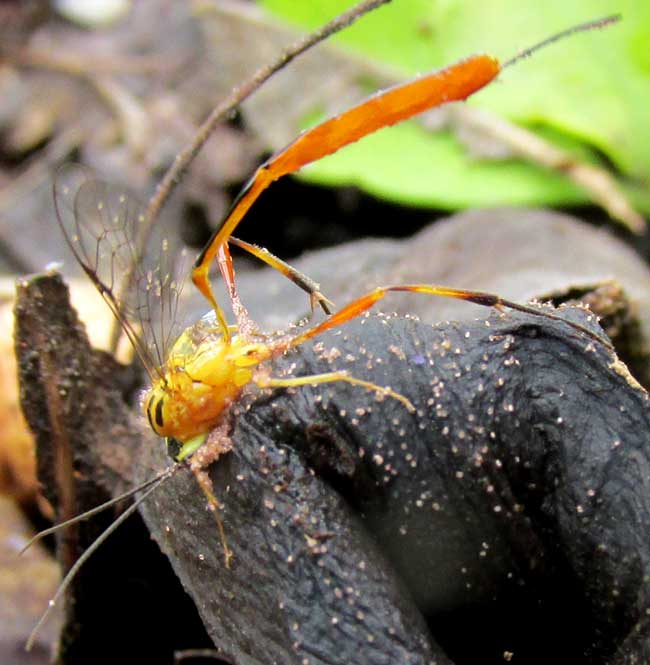Excerpts from Jim Conrad's
Naturalist Newsletter
from the July 3, 2016 Newsletter issued from Hacienda Chichen Resort beside Chichén Itzá Ruins; limestone bedrock; elevation ~39m (~128ft), N20.675°, W88.569°; central Yucatán state, MÉXICO
ICHNEUMON WASP ON THE COMPOST HEAP

I went out to pee on the vigorously composting heap of leaves, banana peelings, squeezed-dry lime halves, pulled-up weeds and such behind the hut, and saw a small, orangish insect hectically rushing from place to place all over the heap, as if fervently looking for something, but never finding it. At the top of this page you can see the critter on a blackened banana peeling.
I had to snap lots of photos before that one turned up -- and even that one isn't so great -- because of the subject's fast movement. Still, even this image shows that our mystery insect bears one pair of transparent wings, the body is pinched to a thread between the thorax and the abdomen and at the abdomen's tip there's a slender, dark something, where on an insect the stinger or egg-laying ovipositor should be.
In other words, this was some kind of wasp, and the slender, dark thing must be an ovipositor, because normally wasps keep their stingers hidden until they're needed. The picture was shipped off to volunteer identifier Bea in Ontario.
In a few days -- a long time for Bea -- a mail came back with the title "Ichneumonid possibly Genus Eiphosoma." and she wrote:
"Yes, this wasp is hard, I got scared away after I read: 'Ichneumonids are notoriously hard to identify: aside from the sheer number of species, there are numerous cases of distant relatives that appear almost identical. Any identification based solely on comparing images should be treated as suspect unless an expert has said there are no lookalikes for the species or group in question.'"
Still, by comparing our image with lots of Ichneumonid pictures on the Internet, she found some looking like ours, in the genus Eiphosoma.
"And this wasp has the:
With the word "Ichneumonid" we're referring to species in the "superfamily" Ichneumonoidea, estimated to embrace over 80,000 species. Members of the Ichneumonoidea normally are referred to in English as ichneumon wasps. Ichneumon wasps are described as solitary insects, most species of which parasitize other insects. Ichneumon wasps belong to the same order as other wasps, ants and bees. Here is how the Wikipedia page on ichneumon wasps describes the wasp's parasitization process:
"The female finds a host and lays an egg on, near, or inside the host's body. Upon hatching, the larval ichneumon feeds either externally or internally, killing the host when it is ready to pupate. Despite looking formidable, the ovipositor does not deliver a sting like many wasps or bees. It can be used by the wasps to bore into and lay eggs inside rotten wood."
Therefore, a good guess is that our fervently searching ichneumon wasp was looking for some kind of grub or maggot inside the compost heap into which an egg could be inserted. The wasp searched the heap for at least 15 minutes, during which time she never found what she was looking for, but kept rushing across the same places on the heap again and again.
In the January, 2014 edition of Revista mexicana de biodiversidad, Enrique Ruíz-Cancino and others published the article "Biodiversidad de Ichneumonidae (Hymenoptera) en México," in which it's stated that just in Mexico we have 1291 known species in 300 genera, with between 3215-4534 species being estimated to exist. Here in Yucatán State, 230 species have been identified, plus in Mérida at the Universidad Autónoma de Yucatán, another 100 species are awaiting identification.
In light of all this it's clear that the orangish ichneumon wasp in our photo has a fair chance of being a "species unknown to science," and even if we find pictures of species looking like ours, we can't have much confidence that ours is the same species. For future researchers, the best we can do is to file our picture and comments here, and wonder if the day will ever come when all these ichneumon wasps are figured out.